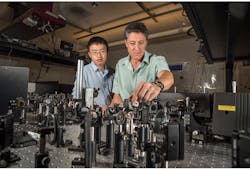Optical Switching in a Trillionth of a Second
A team of researchers at Sandia National Laboratories has, for the first time, used optics rather than electronics to switch a nanometer-thick thin film device from completely dark to completely transparent (or light) at a speed of trillionths of a second. The team decided to do switching or light polarization control using light as the control beam, at terahertz speeds—a rate much faster than what possible using electronics and in a device smaller than other all-optical switches.
Electrons spinning around inside devices such as those used in telecommunications equipment are limited in speed due to a slow charging rate and poor heat dissipation, so to get faster switching demanded a move to photons. To use photons effectively, the technique required a device that goes from completely light to completely dark at terahertz speeds. In the past, researchers couldn’t get the necessary contrast change from an optical switch at the speed needed in a small device. Previous attempts were more like dimming a light than turning it off, or required light to travel a long distance.
The breakthrough shows it’s possible to do high contrast all-optical switching in a thin device, in which light intensity or polarization is switched optically. Then, instead of switching a current on and off, the goal was to switch light on and off at faster rates.
A very rapid and compact switching platform opens up a new way to investigate fundamental physics problems, according to the team. A lot of physical processes actually occur at a fast speeds, at a rate of a few terahertz. This switch will let scientists study the dynamics of physical processes such as molecular rotation and magnetic spin.
The switching technique uses two laser beams: one carrying the information and the second switching the device on and off. The switching beam uses photons to heat up electrons inside semiconductors to temperatures of a few thousand degrees Fahrenheit, which doesn’t cause the sample to get that hot but dramatically changes the material’s optical properties. The material also relaxes in a few hundred femtoseconds, or in less than one trillionth of a second. This let the team switch the material on and off at a rate of a few trillion times per second.
Sandia researchers turn the optical switch on and off by creating something called a plasmonic cavity, which confines light within a few tens of nanometers, and significantly boosts light-matter interaction. By using a special plasmonic material, doped cadmium oxide, they built a high-quality plasmonic cavity. Heating up electrons in the doped cadmium oxide drastically modifies the opto-electrical properties of the plasmonics cavity, modulating the intensity of the reflected light.
Traditional plasmonic materials such as gold or silver are barely sensitive to the optical control beam. Shining a beam onto them doesn’t change their properties from light to dark or vice versa. The optical control beam, however, alters the doped cadmium oxide cavity rapidly, controlling its optical properties like an on-off switch.
The next step is figuring out how to use electrical pulses rather than optical pulses to activate the switch, since an all-optical approach still requires large equipment. The team estimates the work could take three to five years.


